The Shoebill stork bird is a prehistoric-looking bird that is a sought-after treasure by birdwatchers, as it is a solitary bird that isn’t aggressive towards humans and is rather docile, so I wouldn’t call it “scary”, no, but beautiful? I will leave that up to you 😉
Its scientific name is Balaeniceps rex, which is derived from the Latin words Balaena and Caput (abbreviated as Ceps), which stand for whale and head respectively, giving the shoebill another name, the Whale Headed Stork.
In this article, you’ll get to know more about this amazing, and why it fascinates birders so much.
updated 30/11/23
The appearance of the Shoebill stork bird.
This Shoebill bird is quite tall.
The Shoebill stork is a tall bird, with most of its heights ranging from 110-140 cm ( 43-55 in.), and the tallest individuals reaching 152 cm (60 in.).
From beak to tail, the length will average between 110-140 cm ( 39-55 in.), and the wingspan ranges from 230-260 cm (7’7”-8’6”), which makes them well adapted for soaring.
When compared to a human, an adult shoebill is slightly shorter than an average-height adult human.

Shoebill birds display sexual dimorphism with the male being bigger and heavier than the females.
The males will weigh about 5.6 kg (12 lbs.), while the females will usually weigh about 4.9 kg (11 lbs.), but some males will reach weights of 7 kg (15 lbs).
Their shoe-shaped bill is also the third longest in the world, behind pelicans and the larger stork species, and can reach 24 cm (9.4 in.), in length and 20 cm (7.8 in.) in width, which gives the shoebill the tools to hunt extremely large prey.
The bill also has another unique: a razor-sharp, curved hook at the end of the bill. Its feet are quite large and its legs long, and are perfectly suited to its aquatic habitat and hunting techniques.
The colours and wings of the Shoebill bird.
They have grey feathers with the flight feathers being a darker grey, white belly feathers, yellow eyes and a feathered crest at the back of the head.
Just like pelicans and larger storks, when in flight, the wings are held flat, and the neck is retracted.
It also has one of the slowest wing flap rates at just 150 flaps per minute, with the flight pattern alternating between flapping and gliding at a rate of about 7 seconds between each.
Even with such an impressive wingspan, the Shoebill doesn’t like to fly for long periods or distances and has been recorded only a few times flying further than 20 m (66 ft) when foraging.
When they are surprised or flushed, they will fly no more than 500 m (1640 ft).
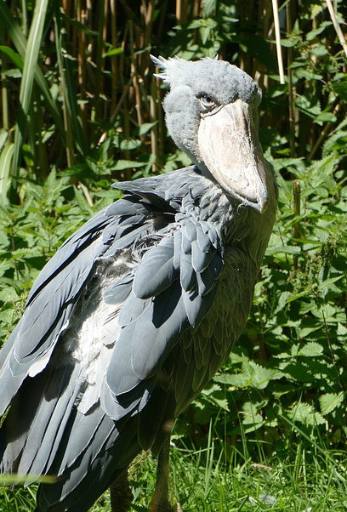
The Shoebill Bird Is An Extremely patient Hunter
The Shoebill is quite sensitive to human interference and disturbances and will often abandon its nests if flushed.
They are also solitary creatures, and will seldom be seen in a group even during the breeding season.
If the population in a certain area is large, shoebills will keep a distance of at least 20 m (66 ft.) from each other.
Despite their size and weight, shoebills will often stand and nest on floating vegetation. One notable behaviour of the shoebill is their ability to stand still for long periods of time, which has led to their description as statue-like.
This slow-paced movement is evident in the way shoebills hunt.
The Shoebill Stork is an extremely patient hunter relying entirely on sight, moving slowly through the water and staying motionless on the lookout for prey.
As they hunt, the massive bill is held vertically down out of the way of the line of sight, since these birds hunt primarily by sight.
When prey is spotted, the shoebill will lunge quite violently, striking and catching prey with its bill.
They are relatively successful as hunters with the success rate being about 60% of the hunts yielding results.
Hippos also help out when they disturb the waters, the fish will come to the surface into the waiting bill of the Shoebill!
Are you thinking about buying binoculars to have a good look at all the magnificent birds of Africa?
The Shoebill’s Diet
These birds are exclusively carnivorous with their prey ranging from different species of lungfish (African lungfish, and marbled lungfish), catfish, and tilapia, to the Senegal Bichir.
Apart from fish, its diet also includes baby crocodiles, Nile monitor lizards, water snakes and frogs.
Its wide, long and sharp beak enables it to hunt prey that is much bigger than what other wading birds usually hunt.
The hook at the end of its beak is also an effective tool in spearing slippery prey such as the Senegal Bichir.
They are diurnal, rarely hunting after dark, except only when there is sufficient light at night such as from a full moon on a clear night. These birds are hardy and can go for up to four days without having scored a meal.
How does a Shoebill bird Breed?
Even though they are solitary, during the breeding season they form monogamous pairs, with the females laying one to three eggs each season.
The nest is built on floating vegetation, or an island among the aquatic vegetation and water and is usually well hidden from prying eyes.
The breeding season is synced to the water levels around them and will begin as the dry season sets in so that the newborn birds will have fledged when the rainy season begins.
When eggs are hatched both parents participate in incubating the eggs for a period of 30 days with the eggs being regularly turned and sometimes doused with water from the shoebill’s mouth.
The young birds fledge at 105 days and are able to fly quite well by the 112th day, and won’t reach maturity until they are three to four years old.
In the video below, you can clearly see how harsh nature can be, even between chicks, we call that survival 😉
The eggs usually hatch asynchronously, and the first chick to hatch has the highest rate of survival as initially there is no competition for food, so it develops rather quickly.
When the second chick hatches, the parents will focus more on the stronger chick and will make no effort at equal distribution of resources.
The elder chick will usually batter and bully the younger and as a result, the second chick will die as a result of starvation or wounds.
Concentrating on one chick ensures a strong and healthy chick that is more likely to survive.
And by laying more than one egg, the second or third egg is an insurance policy to ensure if anything happens to the first chick, then there is another surviving chick.
The Habitat Of The Shoebill Stork.
The shoebill can be found in freshwater swampy habitats, and their distribution can be determined by the availability of food and floating aquatic vegetation.
They, particularly like waters that are poorly oxygenated, as the fish will have to surface more often for air, increasing the likelihood of the shoebill getting a meal.
They are distributed across central and Southern Africa in swampy areas and can be found in Uganda, Kenya, Zambia, South Sudan, Eastern D.R.C., and Tanzania.
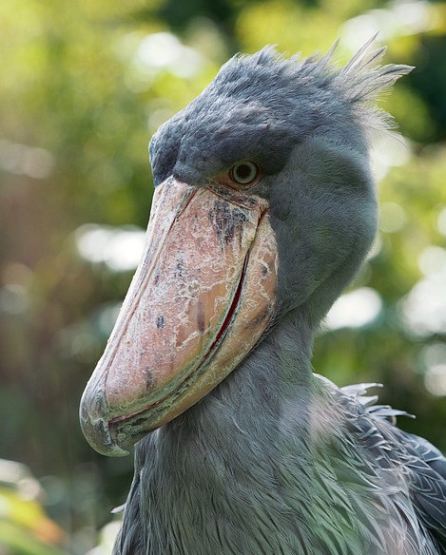
The Health Status Of The Shoebill Bird
Currently, there are estimated to be between 5000-8000 adult birds in the world.
The main threat to them is habitat loss, habitat degradation and hunting.
Due to their solitary, and elusive nature, shoebills are highly sought after, and reports suggest that they can sell for between $10,000-$20,000, making them one of the most expensive birds in the zoo trade.
FAQs On The Shoebill Stork
Is the shoebill a dinosaur?
Shoebills are prehistoric and are said to be related to dinosaurs. Scientists have previously classified them together with ibises, storks and herons, which are based on morphological and behavioural studies.
However other genetic studies place shoebills close to pelicans and hammerheads.
Are shoebills friendly toward humans?
Shoebills are docile towards humans and do not show any aggregate behaviour towards them.
Researchers who have gotten near the bird have gotten as far as 6ft while the shoebill was nesting.
Do shoebills have predators?
On account of their size and weight, adult shoebills have few predators other than humans and crocodiles.
How long do shoebills live?
Shoebills are quite long-lived and in the wild, they can live up to 35 years, and up to 50 years in captivity.
Do shoebills eat crocodiles?
The shoebill is quite large and coupled with their impressive they can hunt prey that is much larger than what other wading birds can manage, but they can’t hunt adult crocodiles, rather they hunt baby crocodiles.
Are shoebills scary?
Now that you have read the whole article, do you still think that shoebills are scary? I think they are fascinating and that they don’t deserve extinction, but that’s just me 😉
Are you thinking about buying binoculars to have a good look at all the magnificent birds of Africa?
My Final Conclusion.
I hope that you enjoyed this blog post on the peculiar Shoebill bird, I found it a fascinating species; looks ànd behaviour!
If you have any more questions about this bird or would just like to chat with me, please feel free to leave a message below in the comment section or join me on my social media channels or Facebook group.
I wish you happy travels and/or birdwatching!
Kind regards,
Lizzy
I now have a YouTube channel as well!
YouTube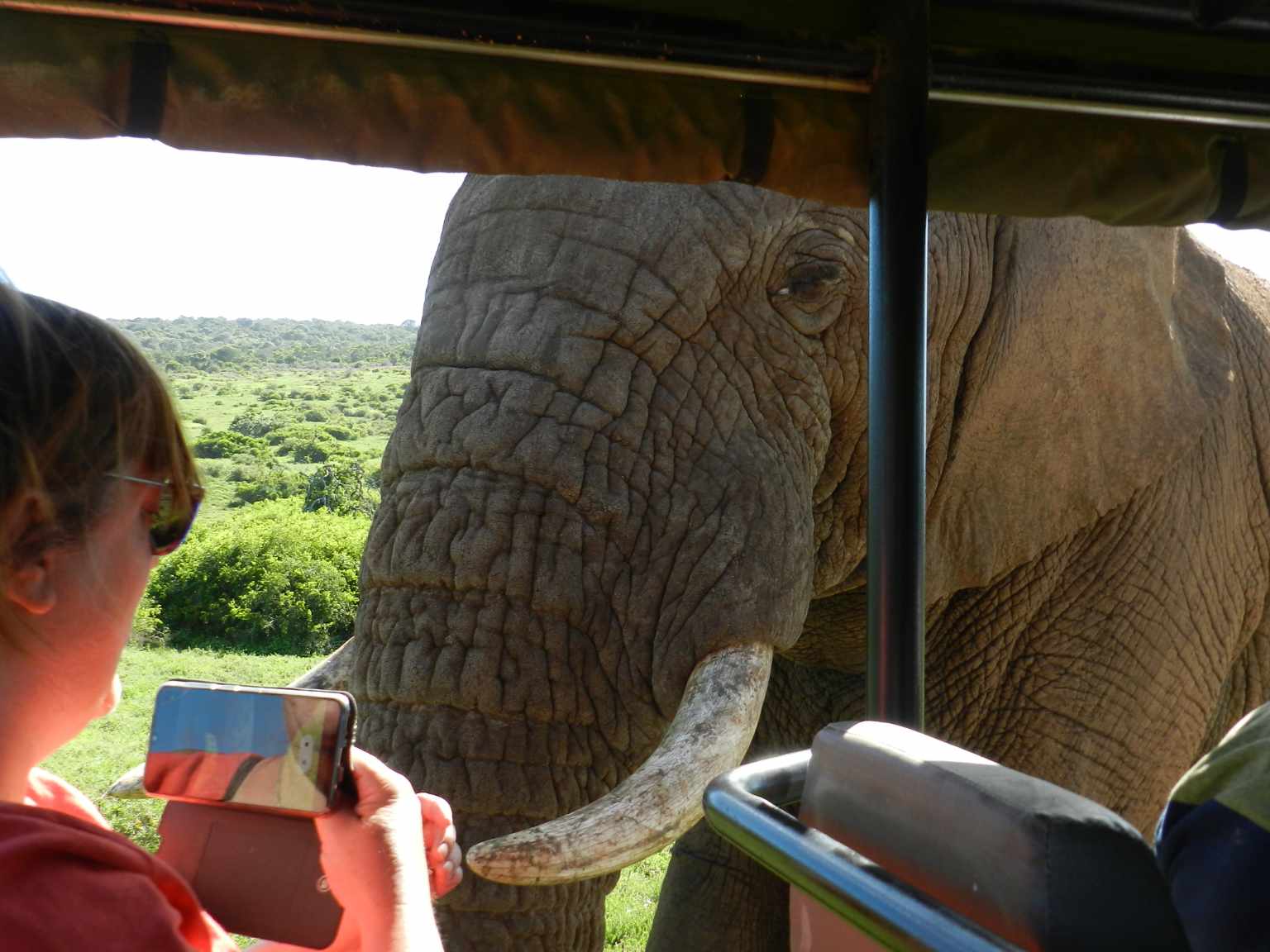
Hello Africa travellers!
Who am I? Well, the least you can say is that I am quite crazy about Africa, its nature, its climate, its culture, and more.
As a young woman in my twenties, I had already traveled to several African countries by traveling along in an overlander on my own and mostly camping ( or glamping ) and just fell in love with the diversity of it all.
So much, so that at the age of 26, I went back to university to study biology, which, unfortunately, I couldn’t finish because of health reasons (yes, I got sick from a tropical disease, oh cynicism). But this did not stop my dream of traveling back to Africa several times, and I still do.
My dream was back then to leave Europe and go study animal behavior, especially the elephants (sure, that’s every girl’s dream haha), but I am also very much intrigued by hyenas and other “ugly African animals“.
So, I “kind of” have a little bit of a scientific approach to my articles, when I write about African birds, for example. And most of all: the passion.
But life goes on, you move from one side of the country to the other, you get sick again and top it off with lower back problems, and before you know it, you are over 50 hahaha!
Now, I still travel to Africa, but take it a bit “easier” than the good old camping days, and stay in comfortable, yet affordable accommodations, together with my husband Wouter.
These are some of the countries I have traveled to: Kenya, Tanzania, Zanzibar, Malawi, Zambia, Zimbabwe, South Africa, Namibia, Botswana, Tunisia, and a little bit of Lesotho LOL .
While clearly not being African territory, but Spanish, I also visited Gran Canaria and Tenerife, and location-wise, I consider them “African”, because of their climate and nature, sue me :-p
The last trip I took was to South Africa in the year 2023, and it sure got the fevers for Africa back! From the Barberton mountains to the Drakensberg and the Southcoast, one month wasn’t enough at all to see the whole country, so we’ll be back! At ease and with a little bit more luxury than in my younger days haha!
I wish you happy travels!
Kind regards
Lizzy

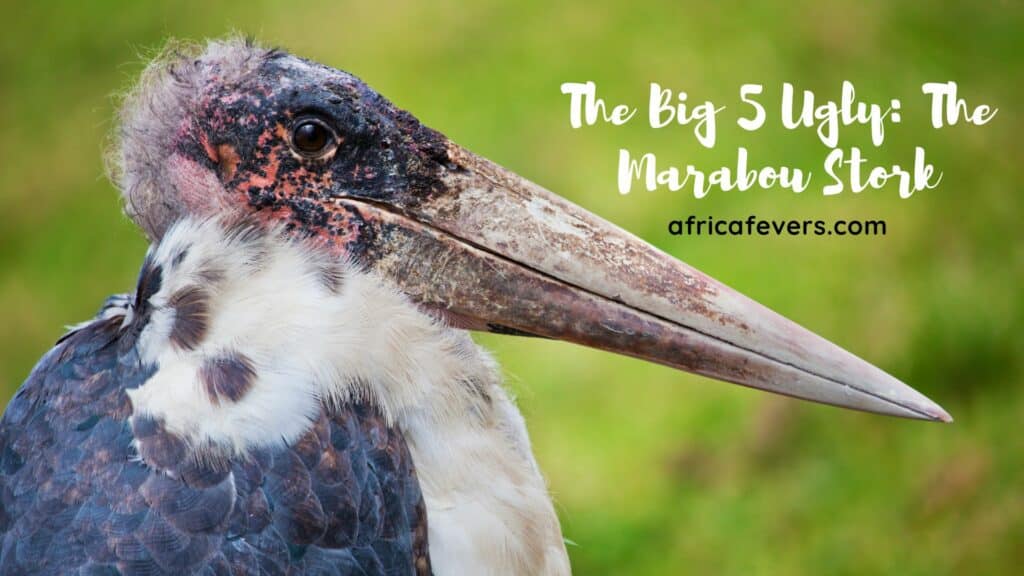
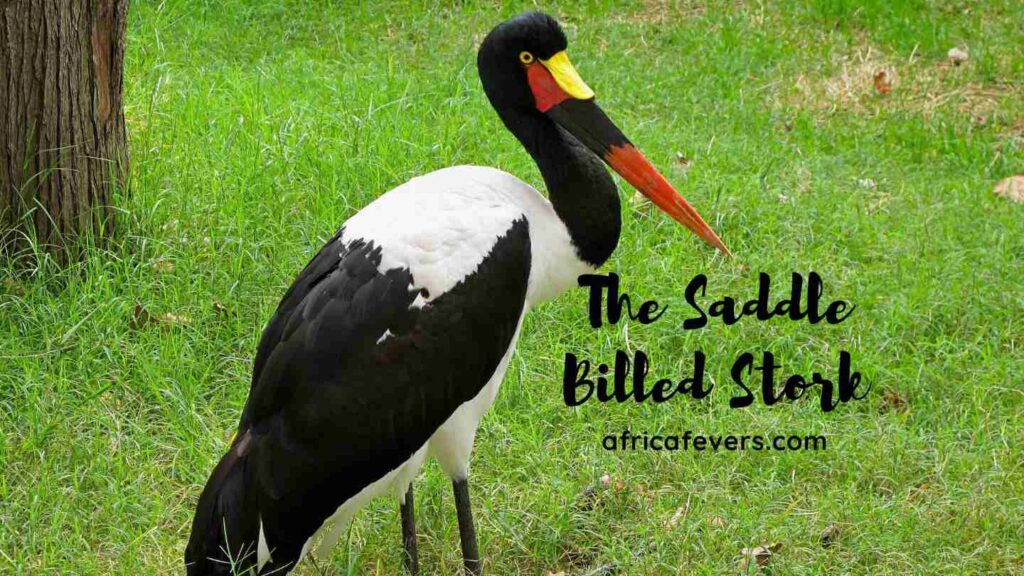
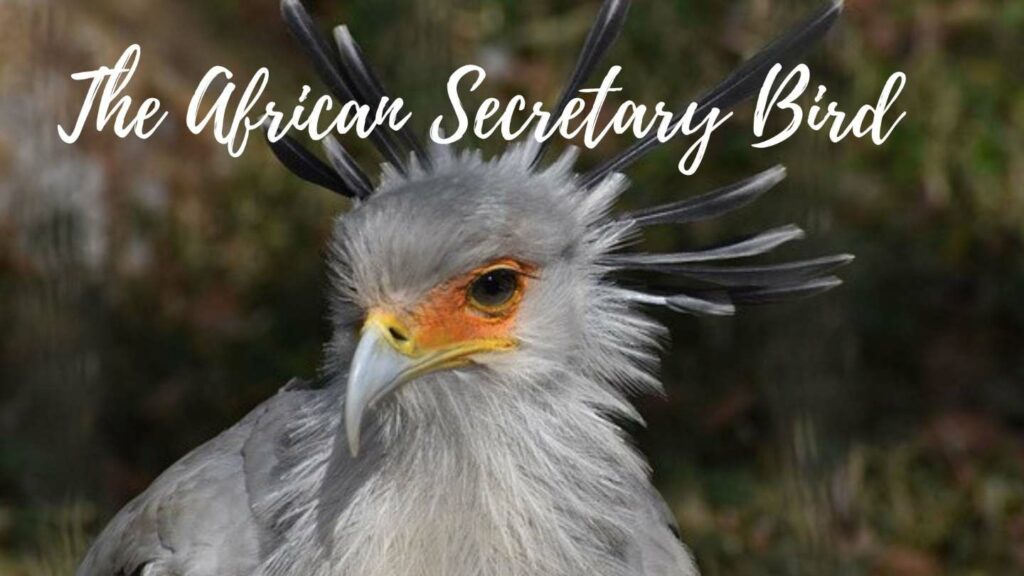
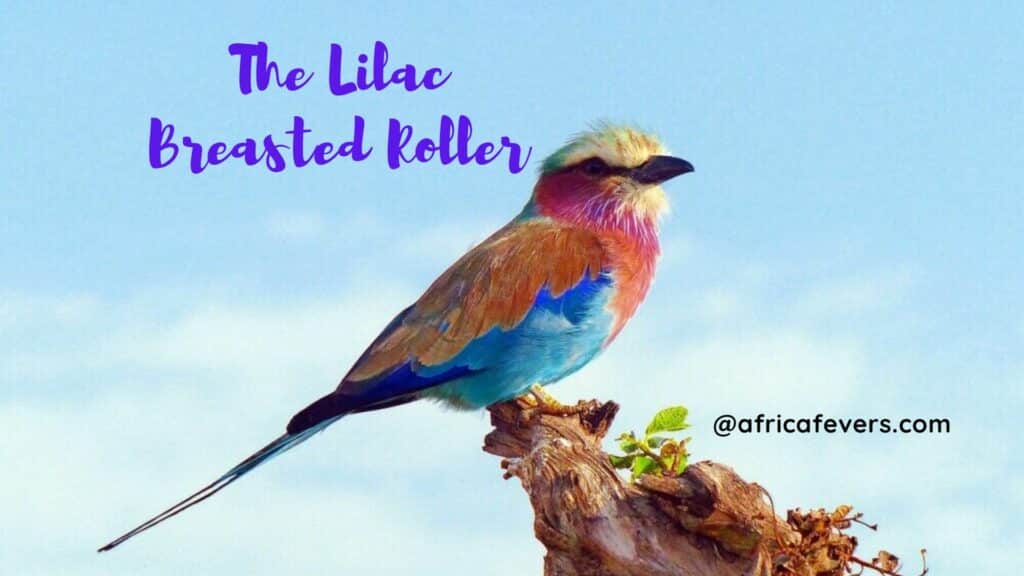

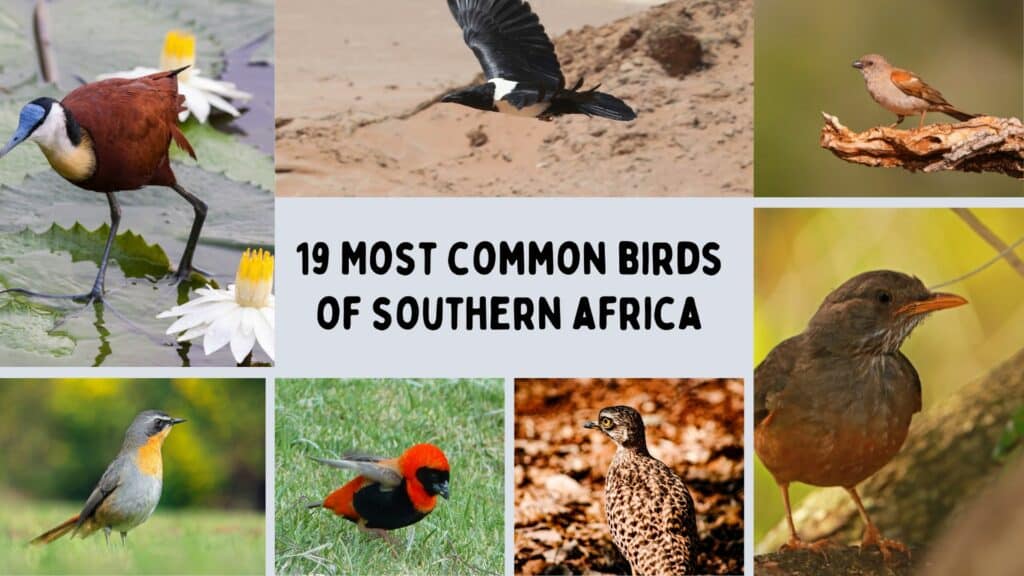
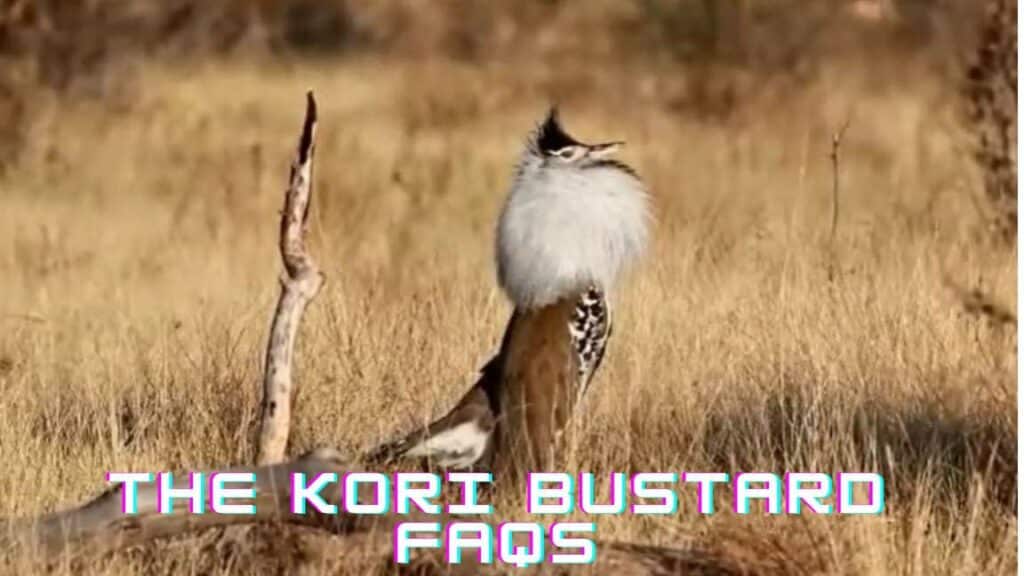
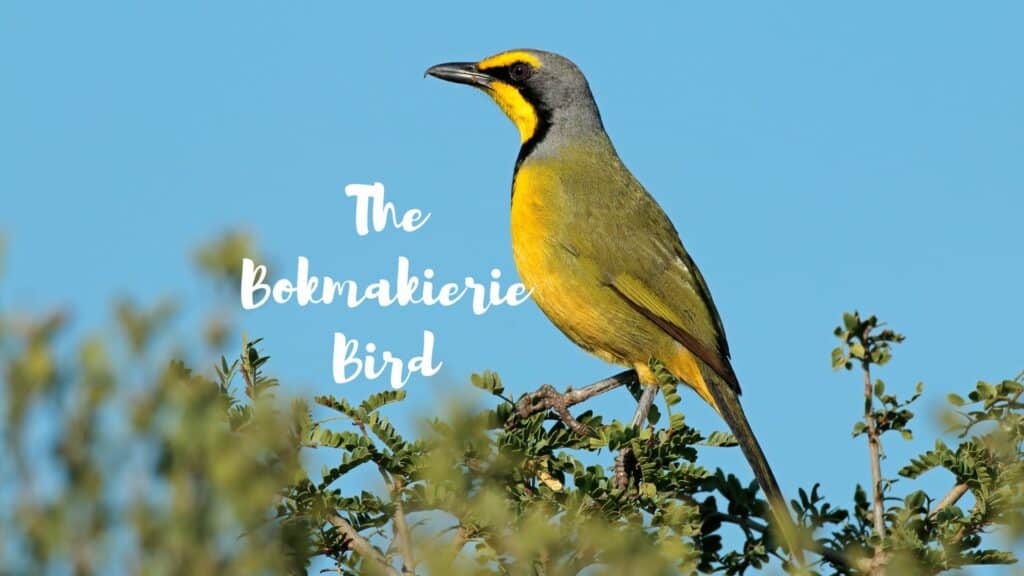
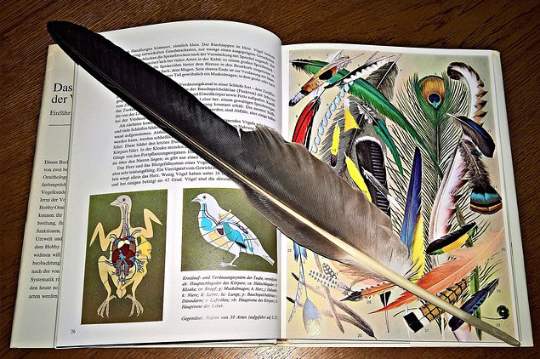
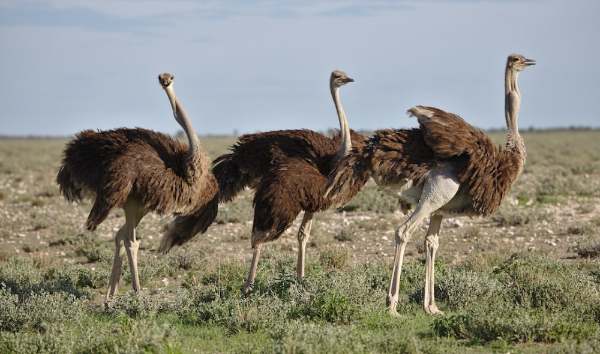
A few weeks ago I saw this bird on a nature program and watch how it hunted, it is interesting to see how tall they are and their appearance. They look like they were from the dinosaur age. Their bill is very huge as well. I watch as the shoebill bird ate another bird that was sort of strange to see that.
hi Norman
The Shoebill stork sure is interesting, right? Thank you for your comment!
I wish you happy birdwatching!
Kind regards,
Lizzy
Hey Lizzy, great article on the Shoebill bird! I’ve always been fascinated by birds, but I must admit, I’ve never heard of the Shoebill before.
First of all, I have to ask, have you ever seen a Shoebill in person? I imagine they must be quite a sight. Also, what inspired you to write about this particular bird?
From reading your article, it seems like there’s a lot of misconceptions about the Shoebill. While they may look intimidating, it’s good to know that they’re actually quite shy and aren’t a threat to humans. I find it interesting how the Shoebill has become a symbol of fear in some cultures, when in reality, they’re just going about their day, hunting for their next meal.
I appreciate how you break down the Shoebill’s appearance and behavior, and how you dispel some of the myths about these birds. It’s always great to learn about new and fascinating creatures, and your article does a great job of educating readers about the Shoebill.
Personally, I think it would be amazing to see a Shoebill in the wild. They seem like such unique and intriguing birds. Overall, I think your article is a great contribution to the world of bird watching, and I hope more people get to learn about the Shoebill. Thanks for sharing, Lizzy!
Hi Bob!
You are totally right that the Shoebill Stork has a lot of misconceptions, which is a shame if you ask me 😉
Oh yes, I did see them in reality, not just on TV and it is an amazing experience! Quite intimidating, but so overwhelming and impressive! I hope you get to see them too some day and I wish you happy travels and birdwatching!
Kind regards,
Lizzy
Thanks for sharing this. African shoebill stork is my favorite and its also found in Busanga Plains.
Hi Mike,
You’re welcome 🙂
Kind regards,
Lizzy